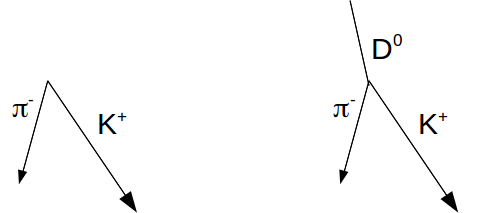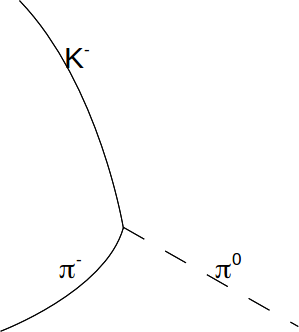When deciphering particles physics diagrams, the follwing observations are helpful,
Momentum is always consevering in collisions. This means that when a particle decays or hits another particle to produce a cascade of particles, the presence of missing particles can often be deduced by looking at the tracks of particles that can be easily detected.
The pion anand Kaon which appear to come from a point in the diagram below are the decay products of a D 0 particle. This particle is neutral so is harder to detect. A more complete diagram is shown on the right. Note that the path of the D0 particle is between the decay propucts – a consequence of conservation of momentum.

We may also see a spontaeous change of direction is a particle track. This occurs when a charge particle decays into a two particles, one of which is neautral. The K - decays into two pions, one of which is neutral and cannot be seen. This produces a kink in the particle track.

Another obvious feature that stands out in many digrams is that the tracks of some particles curve. Magnetic fields are usually made to pass through a region that particles pass so that if the particles have a charge q, as they pass through the field with a speed v they will experience a force![]() at right angles to their own motion and the magnetic field. The force will be equal in magnitude to
at right angles to their own motion and the magnetic field. The force will be equal in magnitude to![]() where
where![]() is the angle between the magnetic field and the motion of the particle and the direction of the force will be given by the left hand rule, considering the particle as carrying a current. Oppositely charged particles will curl in the opposite sense. The degree of the curvature allows some conclusion to be drawn about the masses and speeds of the particles. Latrge particles travelling faster will curve less. The neutral Λ – particle decays into a protons plus electron. The proton has greater momentum, so its path is straighter than the electron. Because proton and electron are oppositely charged, they curl in opposite senses in the magnetic field.
is the angle between the magnetic field and the motion of the particle and the direction of the force will be given by the left hand rule, considering the particle as carrying a current. Oppositely charged particles will curl in the opposite sense. The degree of the curvature allows some conclusion to be drawn about the masses and speeds of the particles. Latrge particles travelling faster will curve less. The neutral Λ – particle decays into a protons plus electron. The proton has greater momentum, so its path is straighter than the electron. Because proton and electron are oppositely charged, they curl in opposite senses in the magnetic field.

